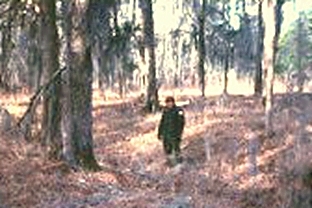Apalachicola Fort Site facts for kids
|
Apalachicola Fort
|
|

Apalachicola Fort Site
|
|
| Lua error in Module:Location_map at line 420: attempt to index field 'wikibase' (a nil value). | |
| Nearest city | Holy Trinity, Alabama |
|---|---|
| Built | 1689 |
| NRHP reference No. | 66000931 |
Quick facts for kids Significant dates |
|
| Added to NRHP | October 15, 1966 |
| Designated NHL | July 19, 1964 |
The Apalachicola Fort Site is an important historical place in Alabama, United States. It is an archaeological site near Holy Trinity. In 1690, Spain built a small fort here next to the Chattahoochee River. They hoped to keep their influence with the Lower Creek people.
However, the fort was not successful. It was used for only about one year and then left empty. It was rediscovered in 1956 by archaeologists. Today, the site is owned by the county, but it is not open to visitors. In 1964, it was named a National Historic Landmark. This means it is a very special place in American history.
Contents
What is the Apalachicola Fort Site?
The Apalachicola Fort Site is in a quiet, countryside area of eastern Russell County, Alabama. It sits on a high piece of land overlooking the Chattahoochee River. This spot was chosen by the Spanish governor, Don Diego De Quiroga y Losada. He wanted it to be close to Apalachicola, which was the main town of the Lower Creek people.
The fort itself was about 72 feet (22 meters) across. It had a strong building called a blockhouse. This building was made of wood and mud, a style called wattle and daub. Around the blockhouse, there was a wooden fence, or palisade. There was also a dry ditch, known as a moat, for extra protection.
Why Was the Fort Built?
Spanish leaders were worried about English traders from the Province of Carolina. These English traders were moving into areas that Spain claimed. The English offered better goods to the Native Americans than the Spanish did.
Spain built this fort to try and keep its power in the northern parts of its claimed land. They wanted to show the Native Americans that Spain was still in charge.
Why the Fort Failed
Building the fort did not work as Spain had hoped. Instead of staying with the Spanish, many local Creek people moved to areas controlled by the English. This made the fort's purpose much weaker. Also, getting supplies to the fort was very difficult because it was so far away.
Because of these problems, the Spanish left the fort after just one year. Before they left, they mostly tore it down.
How Was the Fort Rediscovered?
Even though the Creek village was used again later, the Creek people were eventually moved from the area in the 1800s. The fort site was then forgotten for a long time.
In 1956, archaeologists and a monk from a nearby monastery worked together. They used old records to find the exact spot of the fort. Later digs by archaeologists confirmed that they had found the right place. This led to the site being named a National Historic Landmark. In 1971, the land, which was part of a private farm, was given to the county. It remains a historical site that is not open to the public.

